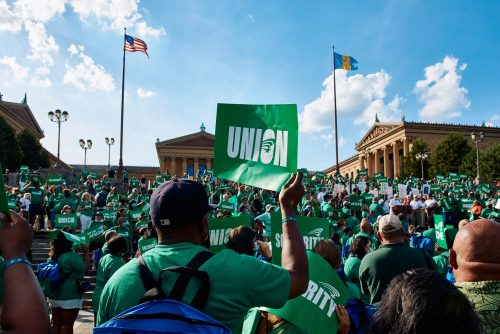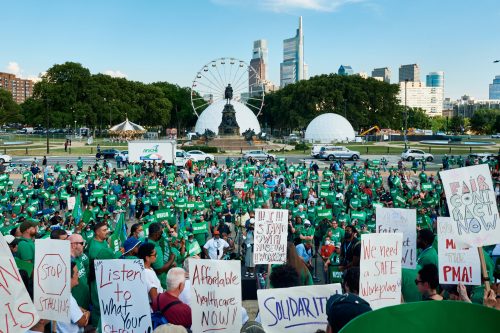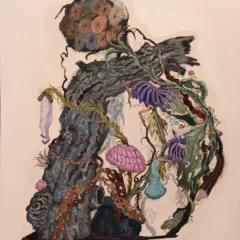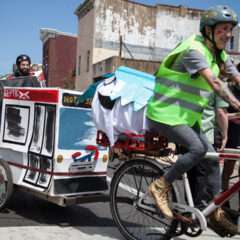
All the recent headlines about museum workers voting to form unions could be seen as a sign that the field is truly, finally, moving in a more equitable direction. However, the news more often than not only celebrates that first step – the vote to unionize. What comes next is the most challenging and delicate for any new union: the negotiation of the first contract with the employer. While less glamorous, this work makes up the crucial threshold between workers advocating for what they need and workers getting what they need.
The threshold can become a bottleneck, and that is where the Philadelphia Museum of Art Union (AFSCME District Council 47, Local 397), and its approximately 200 members, has been stuck since their initial vote to collectively bargain in August 2020. This is not for lack of trying, however, as union representatives have been meeting with the museum administration “roughly once a week” in that time to settle on a new contract for their workers which would address “issues like wages, benefits, harassment, and job security” among others.
To a certain extent, a lengthy negotiation at this phase is to be expected. For example, Bloomberg Law puts the average time it takes to settle on an initial union contract at a somewhat staggering 409 days. Despite this uncomfortably bloated figure, PMA’s union has been at the bargaining table well beyond the national average. If you ask around about why, the uphill battle of working with museum management becomes clear very fast. In an interview for this piece, Union President Adam Rizzo describes these negotiations with the museum as “unpleasant,” and says that certain members of PMA’s administration possess what was described as an outward “disdain” for the union and the needs of the workers they represent.
“Ever since we started this journey, the museum decided that they wanted to be represented by a union-busting law firm, so that’s one thing. After that, they’ve pushed back on everything––even on the things you would think are super simple.” He went on to say that “it has been surprising to me how much they have resisted negotiating meaningful change, and at an institution that has proven itself to be quite flawed over the last few years. The museum is doing everything it can to drag its feet and to move this along as slowly as possible.”
It should come as little surprise then, that after 24 months of stalled negotiations the union was ready to take three dramatic new steps over the last several weeks. On August 26, Local 397 “filed eight Unfair Labor Practice charges with the National Labor Relations Board on behalf of employees at the Philadelphia Museum of Art against PMA management. In the charges, the Union accuses PMA management of repeatedly violating federal law by engaging in union-busting activity during contract negotiations.” Then, four days later on August 30, the union voted with an overwhelming majority to authorize a strike if its leadership deemed it necessary.
Finally, on Friday, September 16th the PMA’s union acted on its strike authorization and executed what they described as a “one-day Unfair Labor Practice strike.” During this strike, the union held many different picket lines around the PMA’s campus for 13 total hours of demonstrations. This “warning strike” draws a firm line with museum management: to showcase that the union is prepared to continue escalating its actions so long as the administration is unwilling to budge at the bargaining table or to fully address the labor charges the union has filed. Whether or not this message will be headed by the PMA has yet to be seen.
Whether it’s negotiating, coordinating with federal officials, or prepping for what seems like an inevitable long-term strike, the work put in by the union members up until now isn’t negligible––there is a real human cost. “It can feel like a second full-time job,” says Adam, on the continued work of organizing and advocating for their demands both internally and externally. And the inevitable toll of this extra labor is certainly a part of the museum’s oppositional strategy. That’s why, now that this pivotal moment for the union has arrived, it is time for community solidarity and focused supportive action to emerge as central players in the contract negotiations.

If you haven’t participated much up until now, consider some of the following steps:
1. Contribute to the Union Strike Fund.
The simplest method of support at this stage is a contribution to AFSCME Local 397’s Strike Fund. While the union up until now has prioritized progress through negotiation, a formal strike may ultimately be required to push through stalled conversations with museum management. A strike fund is a reserve of resources that will help support union members and their families who have had to sacrifice paid working hours to go on a potential strike, especially in the event of a prolonged strike. The more robust their strike fund, the more confidently a union can choose to authorize a strike.
2. Personally Communicate with PMA Management
Regardless of your relationship to the PMA, all residents of Philadelphia and the surrounding areas have some personal leverage they can use to support the efforts of the museum union. At its most basic, this can be simply communicating your position to the museum. Visitors can leave comment cards, tag the museum on social media, or send emails to management. All of these help, but it helps even more when these notes can be functionalized in some way. Are you a former, current, or future member/donor of the PMA? Consider letting them know you don’t plan to sign up or renew until a contract with the union has been successfully reached.
3. Follow the Union Online, and Attend a Future Rally or Picket Line.
Aside from contributing financially and reaching out to the museum directly, it also helps to simply show up during rallies and picket lines, and to follow the union’s efforts online. “It’s so wonderful to see the outpouring of support from people, because sometimes when you are doing this work it can feel like you are all alone doing it, but when you see people coming out and being there, it is really moving and sustaining. It really keeps me going,” says Adam Rizzo. And more than emotionally supporting the union members, it is a big part in showing museum management that their constituents want to see an agreement reached.
–
Learn more about the PMA Union here:
philadelphiamuseumofartunion.com/
instagram.com/pma_union/
–
L Autumn Gnadinger (they/them) is an artist, writer, and educator based in Philadelphia, PA and is an editor for the journal Ruckus.









